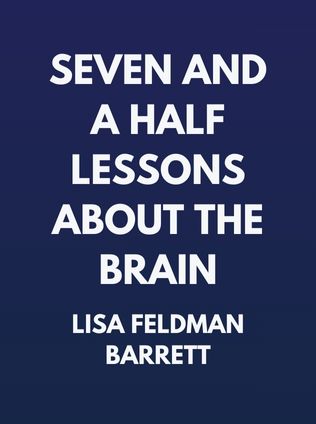
Seven and a Half Lessons About the Brain
By Lisa Feldman Barrett
Published 01/2020
About the Author
Lisa Feldman Barrett, a distinguished neuroscientist, is one of the leading voices in the field of psychology and brain research today. She holds the position of Professor of Psychology at Northeastern University and serves as the Chief Science Officer for the Center for Law, Brain & Behavior at Harvard Medical School. Over the years, Barrett has authored more than 260 peer-reviewed scientific articles and has gained widespread recognition for her ability to translate complex neuroscientific concepts into terms that can be easily understood by the general public. Her previous work, How Emotions Are Made (2017), redefined how we understand emotions, challenging the conventional wisdom that emotions are universal and hardwired. Instead, Barrett presents emotions as constructed experiences, deeply influenced by culture and context. Her mission, as demonstrated in her latest book, Seven and a Half Lessons About the Brain, is to dispel myths and provide readers with a more accurate understanding of the brain's function and potential.
Main Idea
Seven and a Half Lessons About the Brain is a deep dive into the complexities of the human brain, challenging long-held misconceptions and shedding light on the true nature of this remarkable organ. Through a series of seven and a half lessons, Lisa Feldman Barrett dismantles outdated ideas, such as the concept of a triune brain (comprising the reptilian, limbic, and neocortex layers) and replaces them with a more nuanced understanding that emphasizes the brain's adaptability, interconnectedness, and its role in managing the body's energy budget. Barrett’s main thesis is that by understanding the brain’s real functions and mechanisms, we can better control our thoughts, emotions, and behaviors, leading to a more fulfilling and conscious life.
Table of Contents
- Introduction
- How the Brain Is Organized
- How the Brain Operates
- How the Brain Develops
- How Brains Collaborate
- Conclusion
How the Brain Is Organized
One of the most pervasive and enduring myths about the brain is the idea that it is organized into three distinct layers, each corresponding to different evolutionary stages and functions. This model, known as the triune brain theory, suggests that humans possess a "lizard brain" (responsible for basic survival instincts), a limbic system (the seat of emotions), and a neocortex (the seat of rational thought). This theory, which gained popularity in the mid-20th century, has since been debunked by modern neuroscience, yet it continues to influence how many people think about the brain.
Barrett begins by dismantling this simplistic model, explaining that the brain is not a static, layered structure but rather a highly dynamic and interconnected network of neurons. These neurons are capable of performing a wide range of tasks, depending on the demands of the situation. Barrett emphasizes that the brain’s organization is far more complex and nuanced than the triune model suggests. The brain is a plastic, adaptable organ, capable of rewiring itself in response to new experiences and challenges.
“Several parts of the brain are needed to breathe, to feel angry, or to make a plan. It’s not accurate to say that there’s one specific part of the brain that deals with a specific function.” — Lisa Feldman Barrett
This understanding is crucial because it shifts the focus from the brain as a collection of fixed parts to the brain as a flexible, ever-changing system. Barrett explains that neurons, the fundamental units of the brain, form networks that are not rigidly fixed but are instead constantly reorganizing in response to the brain's needs. These networks can perform multiple functions, and the same set of neurons might be involved in different tasks depending on the context. This fluidity is what makes the human brain so resilient and adaptable, capable of learning new skills and recovering from injuries.
For example, consider the common experience of learning a new language. Initially, this task seems daunting because it requires the brain to process and store a vast amount of new information. However, as you practice, the brain adapts by strengthening the neural connections involved in language learning, making the process more efficient over time. This adaptability is a key feature of the brain's organization and is essential for survival in a constantly changing environment.
Another important aspect of the brain's organization is its reliance on networks of neurons rather than isolated regions. Barrett explains that the brain functions as a network of interconnected nodes, where each node can perform multiple tasks. This networked organization allows the brain to be both efficient and flexible, capable of responding to a wide range of stimuli and challenges.
Sign up for FREE and get access to 1,400+ books summaries.
You May Also Like
The Subtle Art of Not Giving a F*ck
A Counterintuitive Approach to Living a Good Life
By Mark MansonHow To Win Friends and Influence People
The All-Time Classic Manual Of People Skills
By Dale CarnegieFreakonomics
A Rogue Economist Explores the Hidden Side of Everything
By Steven D. Levitt and Stephen J. DubnerQuiet: The Power of Introverts
The Power of Introverts in a World That Can't Stop Talking
By Susan Cain



















